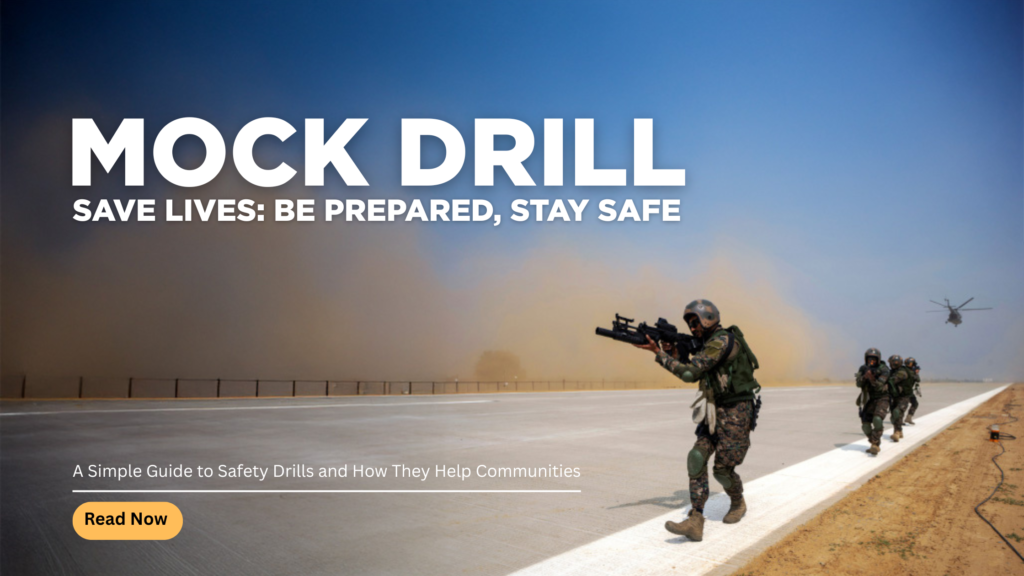A mock drill is a practice activity done to prepare people for emergency situations such as fires, earthquakes, chemical leaks, or terrorist attacks. It is a way to simulate a real-life disaster without any actual danger, so that people can learn how to react quickly and safely.

What’s Going On?
On May 7, 2025, India held a large mock drill called Operation Abhyaas after PM Modi’s announcement about retaliation to Pakistan’s cowardly attack in Pahalgam. It was done in 244 districts and helped people practice what to do during emergencies like attacks or natural disasters. Big cities like Delhi, Mumbai, Chennai, and others were part of it.
People heard warning sirens, lights went out for a short time, and emergency services practiced how to respond quickly. It was all to make sure we’re ready if a real danger comes.
What is a Mock Drill?
A mock drill is a practice activity to teach people how to act in emergencies—like fires, earthquakes, floods, or terrorist attacks. The goal is to stay safe and reduce panic.
Why Are Mock Drills Important?
- They Prepare Us – People know what to do when danger comes.
- They Teach Safety Skills – Like using a fire extinguisher or helping someone injured.
- They Find Weak Spots – So we can fix problems before real emergencies.
- They Build Confidence – People feel more in control during tough situations.
- They Are Legally Required – Many places (schools, offices, factories) must do them by law.
Extra Precautions Everyone Should Know
Here are more simple and important safety tips you can follow to stay safe in different emergencies:
🔥 Fire Safety
- Know where fire exits are.
- Don’t block emergency doors.
- Learn how to use a fire extinguisher.
- Never use elevators during a fire—take the stairs.
🌍 Earthquake Safety
- Drop, cover, and hold on to something strong.
- Stay away from windows, glass, or anything that might fall.
- After the shaking stops, go to an open area.
💣 Terror Threat or Bomb Scare
- Stay calm and listen to authorities.
- Don’t touch unknown bags or items.
- Move away from crowded areas quickly and quietly.
- Report anything suspicious to the police.
🌊 Flood or Heavy Rain
- Don’t walk or drive through water.
- Move to higher ground.
- Turn off electricity and gas if water enters your home.
💊 Chemical or Gas Leak
- Cover your nose and mouth with a cloth.
- Leave the area immediately.
- Don’t turn on fans or lights—they may spark a fire.
- Tell others to evacuate calmly.
🧒 Child Safety Tips
- Teach children emergency numbers (like 100, 101, 108).
- Show them safe exit points at school or home.
- Practice drills with your family at home.
How to Make More People Aware
- Community Awareness Events
- Host simple workshops at community centers or local parks.
- School Safety Days
- Organize yearly mock drills and safety talks in schools.
- Social Media Campaigns
- Share videos, posters, and tips online with family and friends.
- Posters and Flyers
- Put up safety tips in buildings, shops, and public places.
- Public Announcements
- Use loudspeakers or radios in villages to explain safety steps.
- Get Local Leaders Involved
- Ask teachers, doctors, and local officers to help spread the word.
Conclusion
Mock drills are not just a formality—they are a powerful way to prepare for emergencies and protect lives. Whether it’s a fire, earthquake, flood, or terror threat, knowing what to do in a crisis can make a huge difference. By practicing regularly, spreading awareness, and teaching safety steps in schools, workplaces, and communities, we can build a culture of preparedness.
Everyone—children, adults, workers, and leaders—has a role to play in staying safe. The more we talk about safety and practice it, the more lives we can save. Let’s take mock drills seriously, follow safety precautions, and encourage others to do the same. Together, we can make our surroundings safer and more resilient.